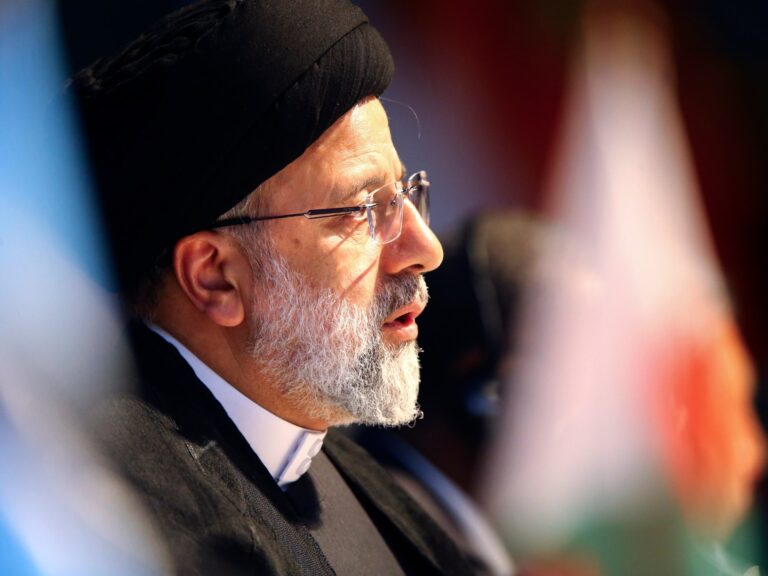Iranian President Ebrahim Raisi disappears after the helicopter he was in went down in the province of East Azerbaijan.
This 63-year-old political heavyweight has long been considered the natural successor to Supreme Leader Ayatollah Ali Khamenei, Iran’s highest authority.
With an established presence and deep ties within the judiciary and religious elite, Raïssi – a radical and religiously conservative politician – first ran for president in 2017, but failed. . He was finally elected in 2021.
First years
Raisi began studying at the famous religious seminary in Qom at the age of 15 and continued to learn under several of the most senior clerics of the time.

In his early twenties, he was appointed prosecutor in several successive cities until he went to Tehran, the capital, to work as a deputy prosecutor.
In 1983, he married Jamileh Alamolhoda, the daughter of the Friday prayer imam of Mashhad Ahmad Alamolhoda. They had two daughters.
For five months in 1988, he served on a committee overseeing a series of executions of political prisoners, a history that made him unpopular among the Iranian opposition and led the United States to impose sanctions on him. against. In 1989, he was appointed Tehran prosecutor after the death of Iran’s first supreme leader, Ayatollah Ruhollah Khomeini.
Raisi continued to rise through the ranks under Khomeini’s successor, Ayatollah Khamenei, becoming president of the Astan Quds Razavi, the largest religious foundation in Mashhad, on March 7, 2016, which consolidated his status within the Iranian establishment.
Candidacy for president
Raïssi first ran for president in 2017 against Hassan Rouhani, who was a candidate for re-election. Rouhani had overseen negotiations for Iran’s 2015 nuclear deal with world powers, limiting its nuclear program in exchange for sanctions relief.
A critic of the 2015 deal – known as the Joint Comprehensive Plan of Action (JCPOA) – Raisi comes from a tougher bloc than Rouhani, who was seen as a political moderate within the Iranian political system.
After his defeat, Raïssi began planning his next presidential campaign. In June 2021, he won 62 percent of the vote, but the election was marred by low turnout – 48.8 percent – after several reformists and moderates were blocked from running.
By then, the JCPOA was in shambles after the United States – under former President Donald Trump – unilaterally withdrew and reimposed its sanctions on Iran, severely affecting its economy.
The COVID-19 pandemic has made the situation worse, with death toll exceeds 97,000 by August 2021.
Connections
Raisi’s credentials within the religious establishment are strong, with strong relationships with the late Khomeini as well as Khamenei, who appointed him to several senior positions.
He also managed to maintain good relations with all branches of government, military and legislative, as well as the powerful theocratic ruling class.
However, Raisi has led Iran at a time of public anger over deteriorating living standards, in part because of sanctions and what critics say is a prioritization of defense over domestic issues. .
In late 2022, public anger erupted following the death of Mahsa Amini in the custody of Iranian morality police, who arrested the 22-year-old as she left a Tehran metro station with family members for alleged failure to comply with the country’s rules on compulsory wearing of hijab.
Protests have rocked Iran for months, with women removing or burning their hijabs and cutting their hair in protest.
The rallies ended in mid-2023 after a few 500 people were killed when security forces intervened to disperse the protests, according to foreign human rights organizations. Seven people were executed for their role in the unrest.
A United Nations fact-finding mission concluded in March this year that Iran had committed crimes against humanity in repression, including murder, torture and rape.

Dead ends
Raïssi did not hesitate to face international confrontation either.
Angered by the United States’ stance on the JCPOA and the failure of other signatories to save the deal, Raisi defiantly announced that Iran was stepping up its nuclear program, but that it was not not interested in a bomb.
Most recently, he led Iran through a confrontation with Israel as the two countries clashed over Israel’s relentless assault on Gaza, now approaching its eighth month.
Iran has openly condemned Israel’s brutal attacks on Palestinian civilians, as have its regional allies in the so-called “axis of resistance” to Israel and its Western allies.
In early April, the Iranian consular building in Damascus was attacked in a strike blamed on Israel, killing seven people, including one commander in chief and his deputy.
For nearly two weeks, every statement by Raisi faced scrutiny as the world awaited Tehran’s response. On April 15, Iran launched a well-telegraphed attack which, according to Israel’s chief military spokesman, Daniel Hagari, involved more than 120 ballistic missiles, 170 drones and more than 30 cruise missiles, most of which were intercepted outside Israel’s borders. Minor damage was reported in parts of Israel, and the attack prompted a symbolic response.
The regional rivalry between Iran and Israel could also be seen in Syria, where Israel launched multiple attacks over the years, ostensibly targeting Iranian military capabilities there.

Iran has maintained close relations with Syria for years, supporting President Bashar al-Assad since he ordered a violent response to peaceful protests in 2011 that led to 13 years of civil war. With military and tactical support, Iran has expanded its influence in Syria while the Lebanese allied group Hezbollah has also strengthened Assad’s forces.
Between maintaining established foreign policy and managing new domestic and international confrontations, Raisi has thus far proven to be a controversial president.
However, his close relationships at all levels of the Iranian establishment have also made him a serious candidate for a second term, and perhaps for the country’s highest office, that of Supreme Leader.


